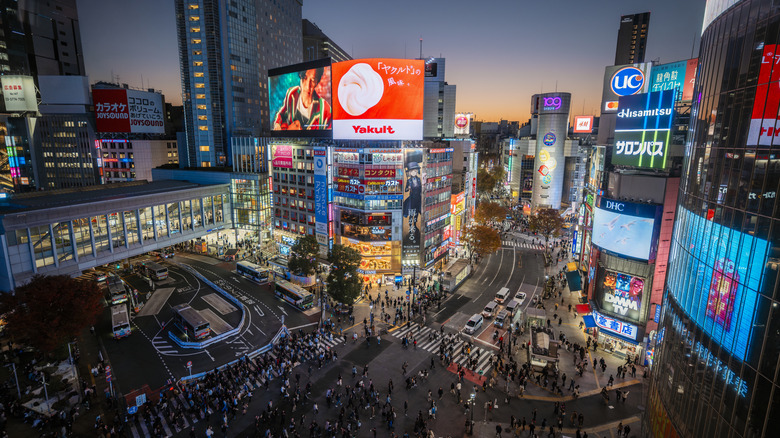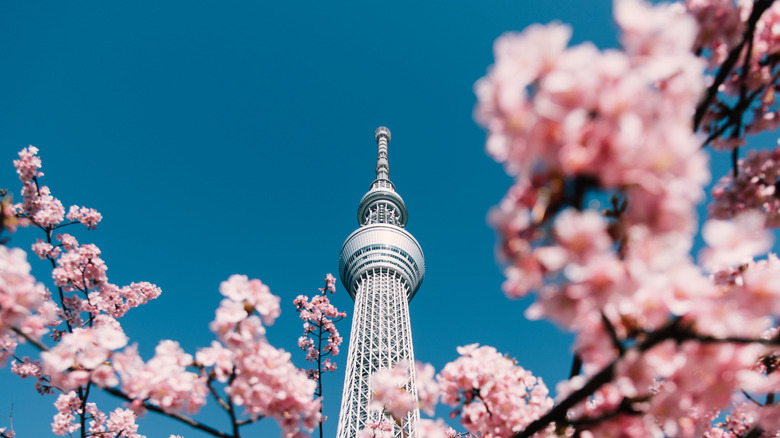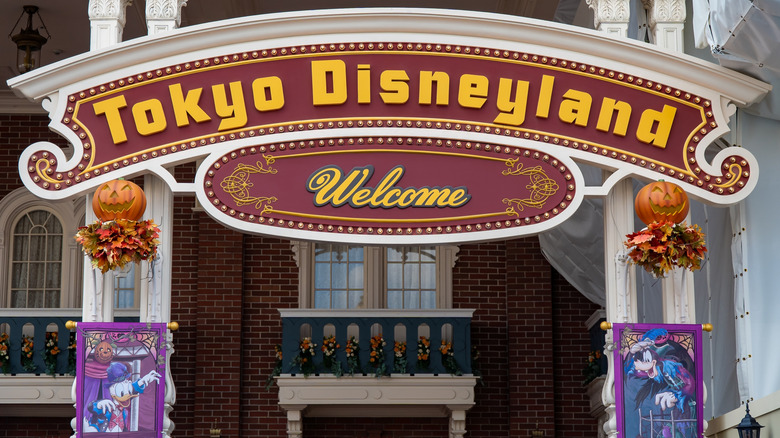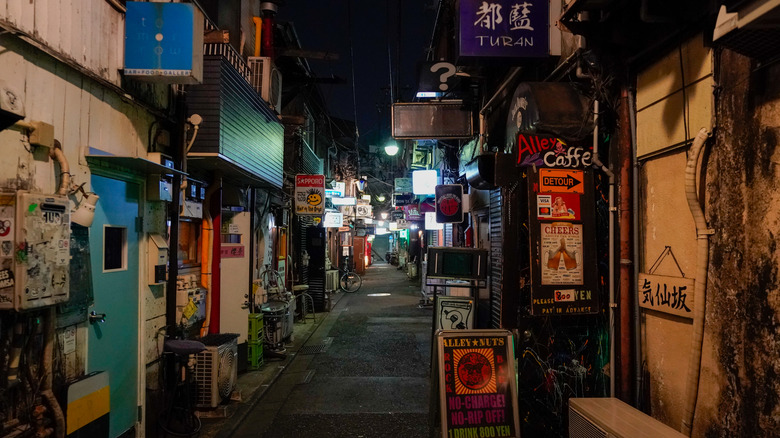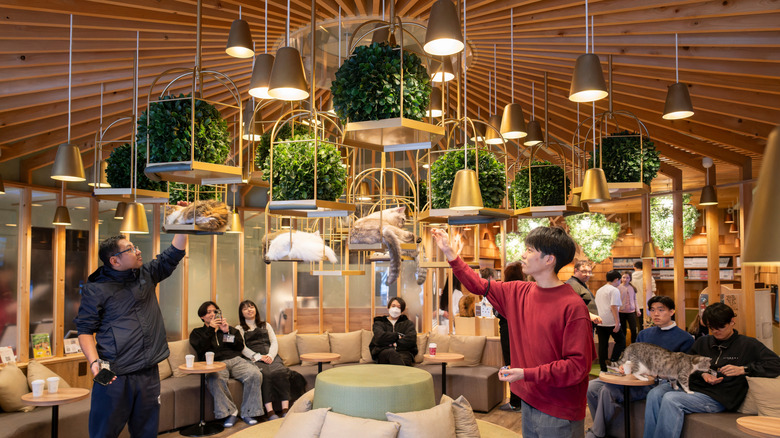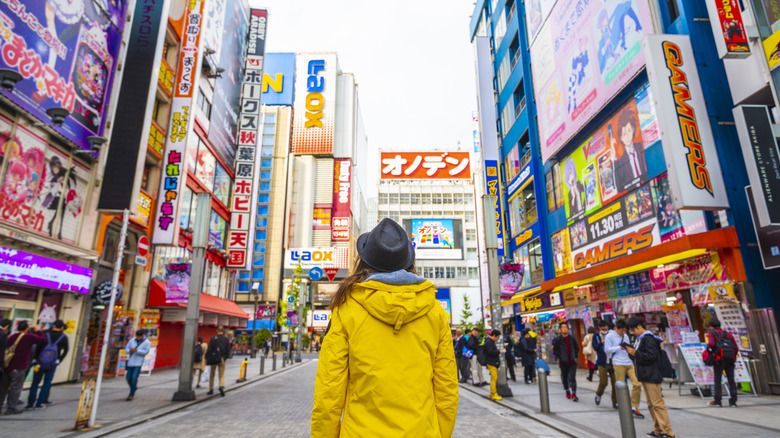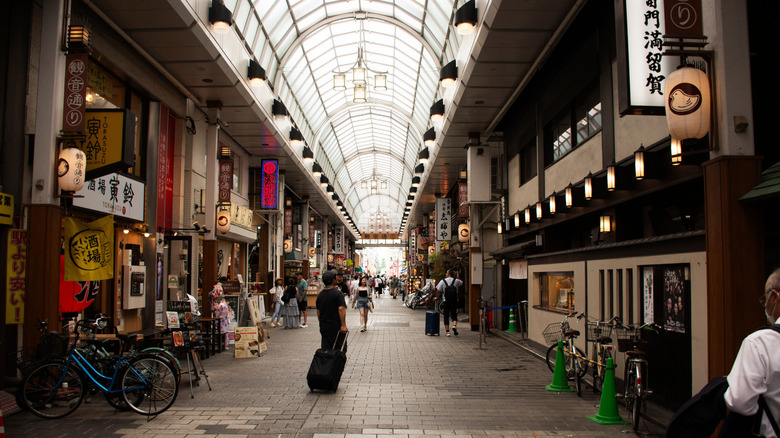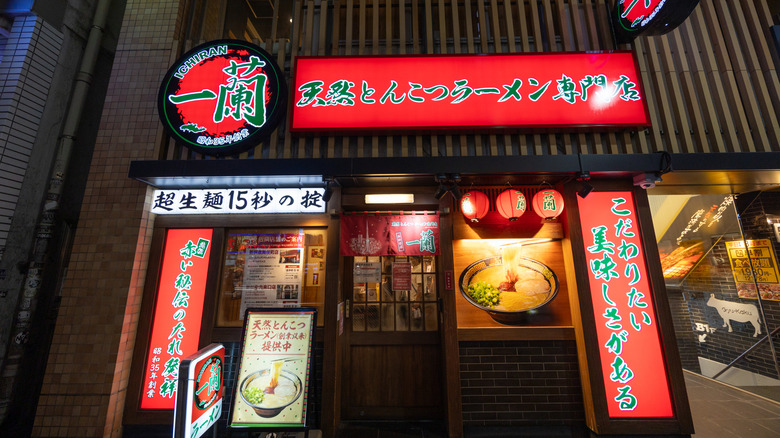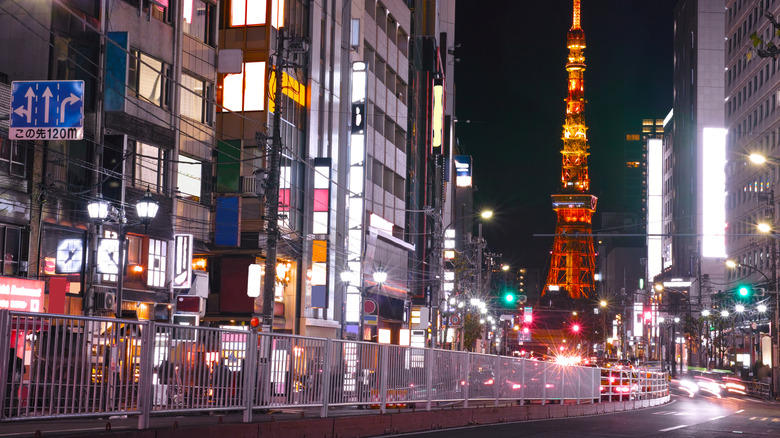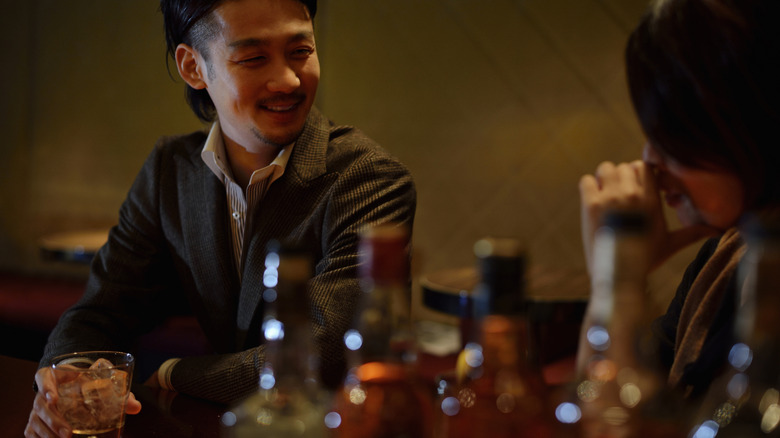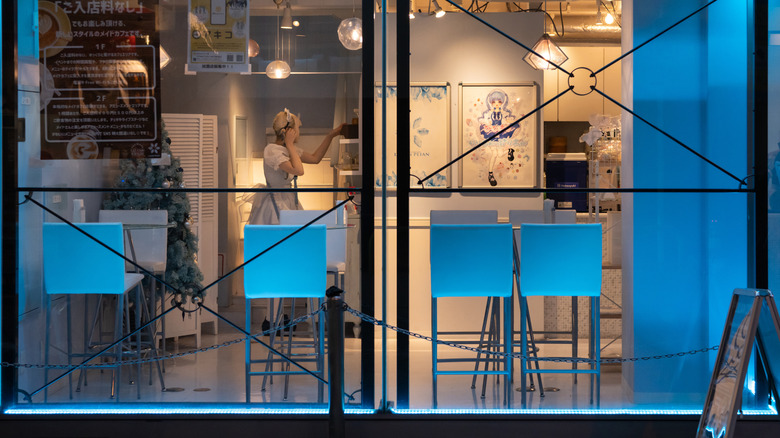Tourist Traps You Should Probably Steer Clear Of In Tokyo
A trip to Japan might be a once-in-a-lifetime experience for tourists crossing the vast Pacific Ocean. The culturally meteoric island nation has been at the forefront of the Western mindset for centuries. In 1543, Portuguese sailors blown ashore by a typhoon became the first Europeans in Japan, sparking a seismic shift in the way European exploration and trade interacted with the East as a whole. In modern times, fascination with all things Japanese persists, and over half a million American tourists arrived in the country between just January and April 2023.
With the enormous volume of Americans and other visitors flocking to Japan — a country that U.S. citizens can travel to visa-free — there are naturally going to be some highlights that simply must be on your list of things to do. Similarly, a number of tourist traps feature in the fabric of a Japanese visit, just as they would on any other vacation to a new place. This is particularly important when visiting the country's modern capital, Tokyo. Sites like Shibuya Crossing (a great place to bring teenage travelers) are often high on a visitor's list, but others like the Tokyo Skytree viewing deck might be better left off. With so much going on in Tokyo, it's actually quite easy to find excellent alternatives to these kinds of less-than-ideal tourist magnets. Shying away from these tourist traps and instead prioritizing alternatives that offer a more authentic experience can amplify the memories you make while walking the glowing streets of Tokyo.
Tokyo Skytree and Tokyo Tower
Visitors trying to make the most of their trip to Tokyo will often seek a viewing platform that overlooks the city from a great height. These kinds of vantage points are iconic components of many cities worldwide; from the Shanghai Tower's observation deck on the 118th floor to the KL Tower in Kuala Lumpur, tourists across Asia and the world are constantly looking to climb a metropolitan area's highest peaks in order to look down over all that the city has to offer. Tokyo is no different, and the sprawling urban haven of activity features two prominent tourist attractions in this pantheon of elevated viewing decks, as well as a third that doesn't always get the same amount of love.
Tokyo Skytree and Tokyo Tower are frequently highlighted but simply less viable options in comparison to the Metropolitan Government Building. This alternative viewing deck is easy to get to, with access directly off of the Tochōmae station on the metro. Tokyo Tower and Tokyo Skytree are both overpriced and extremely busy, as well. Therefore, a visit to the Metropolitan Government Building viewing deck is much cheaper than the tourist traps, and you'll have quite a bit more freedom to wander around once you reach the top. As someone who's personally been up to the top of the Tokyo Metropolitan Government Building, it's absolutely worth the visit.
Tokyo Disneyland (with a caveat)
Tokyo Disneyland offers some interesting and important differences from the American Disney experience. If you're going to Tokyo Disneyland because you are a huge Disney fan, this theme park shouldn't be considered a tourist trap. Prices at the Tokyo Disney complex are generally very reasonable, with entry tickets and food inside the parks costing less than they would in their American equivalent. There are also a number of areas within the park that were styled after the original Disneyland construction in California and haven't been updated alongside the changes that have taken place back home. This allows visitors to catch a kind of glimpse back in time at what Disneyland was like early on in its constantly evolving existence. Also, DisneySea is an entirely novel park that deserves recognition and exposition (it has also been named Disney's best theme park).
However, if you're looking to enjoy a day out at a theme park and aren't particularly taken aback by the Disney experience, there are other options in Tokyo that will provide a better memory to take home. Even with some important differences in Tokyo Disneyland, the bones of the park remain largely similar to other Disney theme parks located around the world. Instead, visiting Odaiba will bring you to a unique cultural theme park experience. The indoor park Joypolis, alongside authentic street food, game centers, and rollercoasters, offers a truly remarkable day of fun. You might even decide to head out of the city to ride the intense rollercoasters at Fuji-Q Highland Theme Park if you have the time.
Shinjuku's Golden Gai neighborhood
The Golden Gai neighborhood in Shinjuku has frequently been cited as a nightlife highlight for visitors to modern Tokyo. However, the maze of alleyways and dense roads has seen some important changes in recent years, and not in a good way (as it relates to tourists). The buzzing activity throughout this alcove of Tokyo has shifted from a thriving space for artistic expression and community connections to a far more commercial atmosphere. Today, the hundreds of bars, cafes, and restaurants lining its streets are more likely to charge entrance fees and high prices than offer an authentic experience.
Insiders with knowledge of the Tokyo nightlife scene recommend visiting Shimokitazawa and Nonbei Yokocho instead. These neighborhoods are near (and, in the case of Nonbei Yokocho, right within) Shibuya. This makes them both easy to get to, and the evening you'll enjoy in either Tokyo neighborhood will be far more authentically Japanese. Both areas aren't specifically glossed up to cater to tourists. This means that dinner and drinks here will be enjoyed sitting alongside locals, and the atmosphere and prices will match that idealized environment.
Animal cafes
No one does cat cafes quite like Tokyo, but be warned: Animal cafes are typically overpriced for the total package you're getting. In many of these establishments, you'll pay separately for the time spent in the cafe and additional elements of the experience. This includes drinks and food items you might want to indulge in, and interacting with the animals in the cafe may also come at an additional cost. The conditions inside these kinds of restaurants may not always be entirely hygienic, either. With a collection of live animals comes the reality of loose fur, random bathroom breaks, and potentially additional pathogen and bacterial exposure. Not only does this open you up to increased risk, but it might not smell great or visually offer a relaxing vibe within the café.
On top of these considerations, there's also the fact that you can't be sure of how the animals are treated when there are no customers in the facilities. There's no reason to expect that any particular café is treating its animals inhumanely as a blanket rule; generally speaking, Japanese people are caring and compassionate toward animals. However, when animals become part of a business operation's plan for success, no matter how much a person might love them, it can be difficult to maintain high standards of care. Profits drive much of the policy that any business will enact for itself, and this naturally covers the people and animals that contribute to its daily operation.
The anime-lined streets of Akihabara
Akihabara is one of the most recognizable landscapes in all of urban Tokyo. The brightly lit signs and buildings that glisten everywhere in Akihabara advertise all kinds of unique video games, anime, and character experiences. Akihabara also features to-die-for milk stands that visitors shouldn't miss! Giant arcade facilities can be found sprawled across the vertical tapestry of the neighborhood, and visitors hoping to enjoy a circuit in real-life Mario Kart-inspired vehicles will often do so cruising the streets of Akihabara (just be careful if you're planning to take on this potentially dangerous activity).
Coming to Akihabara to take in the spectacle of it all is a great option to include in your itinerary. The neighborhood is simply magical in its visual aesthetic. The lights, the busy streets, and the energy of the place are undeniable, surely adding to the neighborhood's overall allure for foreign visitors (and locals alike). But, if you are an anime and manga fan or a shopper looking for specific memorabilia and collectibles in other general categories, Akihabara isn't the place for you. Beyond the surface-level glitz and glam of the neighborhood, actually going into shops and purchasing items here will see you spend at a marked-up rate. Because Akihabara is so heavily visited by tourists, alternatives like Nakano Broadway make for a better purchasing experience with quieter shops that allow for more leisurely browsing and more favorable pricing all around. This includes collectibles like video games, figurines, and manga issues.
Nakamise street market
Street markets are major draws for tourists visiting Tokyo. The Tsukiji Outer Market, for one, is a centrally located triumph of cuisine and culture. Plenty of other open-air marketplaces factor into the schedule when exploring Japan and Tokyo. One that's often high on the minds of tourists is the Nakamise street market. The classic shopping street has long been a haven for traditional souvenir shops and small eateries, but as is the case with many localized gems across the world, the street market has taken a noticeable turn toward greater levels of catering to tourists. The market is consistently busy to the point of discomfort, and a growing changeover to cheap trinkets and lower-quality food items has left the traditional charm of the market behind.
There are still some vestiges of the market's character, including the fact that it runs right into Sensō-ji Temple, creating an atmosphere intensely colored by its iconic backdrop. However, with other markets also finding themselves integrated throughout the local community, a visit to one with huge foot traffic taking away from the ambiance simply isn't necessary. Instead, options like Ameyoko street market offer a similar traditional flair without the intense competition for walking space. The area is far less crowded, and with lower volumes of foot traffic come better prices overall. You'll find other kinds of souvenirs and collectibles here, too, making it another excellent option for buyers hoping to steer clear of the markups in Akihabara.
Waiting in line to eat ramen at Ichiran
Ramen noodles are perhaps one of the most iconic cuisine staples to come out of Japan. Americans will largely know this dish as an insanely cheap meal option that comes in a dried packet with some added seasoning powder to round out the flavor. Whether you typically indulge in the decidedly un-luxurious flavorings of ramen noodles cooked on the stove or its close cousin that gets microwaved in a cup, authentic Japanese ramen is absolutely not this. In fact, the only similarity is the general type of noodle; authentic ramen is painstakingly willed into being, cooked for hours or days at a time to deliver insane flavor. These dishes are rounded out with boiled eggs, added vegetables, and meats, perhaps sliced pork or shrimp.
Many visitors heading to Japan will have heard of Ichiran, one of the country's options for getting a bowl of authentic noodles. The restaurant itself isn't exactly a tourist trap, but it's developed such a reputation that you'll frequently end up standing in line for quite a long time in order to get your fill. However, the draw of Ichiran isn't the noodles, leading the charge in this chain restaurant's inclusion here. The food is great, but the individual cubicles that you are served in form the basis of what many tourists come to see. The experience is unique, to be sure, but with so many fantastic ramen options found throughout Tokyo, there isn't a great reason to stand outside one waiting for your meal if you don't have to.
Essentially any Roppongi bar with a barker outside
Roppongi is a Tokyo neighborhood that many tourists will be familiar with. The area has been a magnet for those seeking nightlife in Tokyo for many years, and restaurants and bars can be found in abundance here. But Roppongi has become less authentic and more touristy in recent years, with the general quality and authenticity suffering and tourist-geared price increases becoming the norm rather than the exception. There are certainly a number of wonderful establishments still found in this part of Tokyo, and visitors hoping to experience a wide range of local traditions and tourist hotspots may still prioritize a trip to the Roppongi neighborhood.
If you are going to explore this area, a good rule of thumb is to look out for bars and restaurants with a dedicated barker (also known as a "tout" in Japan) standing outside. As is the case with many other parts of the world where travelers frequent, establishments that seek to bring in customers this way are often only interested in serving tourists. Anyone who's spent time in a beachside community in Europe or elsewhere in Asia, for instance, will likely be familiar with this sight. Restaurants that deploy barkers outside their doors in Roppongi are almost always less authentic and more expensive, designed to overcharge tourists who may not know any better.
Host and hostess clubs
People who have been salivating over the chance to visit Japan for a long time and have developed extensive plans may already understand the host and hostess club scene (called kyabakura). Japan is full of unique cultural icons, and intermingled alongside things like its arcade game district and anime centers (in places like Akihabara) is the host and hostess club. Not to be confused with a brothel or anything similar, these clubs are an opportunity for companionship and conversation in a friendly and relaxing environment. These clubs will serve drinks and pair visitors with an attractive conversation partner to spend time leisurely chatting.
These establishments have been around for quite some time in Japan, and they're popularized in anime culture and elsewhere. Tourists looking to dive straight into Japanese culture when they arrive in Tokyo might be interested in this unique conversational experience. However, if you are new to the concept of this type of club, you may not be prepared to fully understand the rules, price structure, and other elements. Indeed, this experience can become incredibly pricey in a hurry. An alternative is to simply visit an international party. These are gatherings where Japanese people freely look to meet and chat with foreigners. You'll get to talk about whatever might be on your mind, and your conversational partner will get to pick your brain about your culture and identity. It's a win for everyone and comes at a much more affordable price.
Check out a themed restaurant instead of the maid cafes
In the same way that animal cafes can ultimately be a letdown for visitors, maid cafes frequently don't hit the mark when compared to the image a tourist might hold in their mind. When heading into a maid cafe, you're almost certain to overpay for the experience. Getting drinks at the cafe typically isn't included, and the people who work in these establishments don't always speak very good English, if at all. This means that if you can't hold a conversation in Japanese, you might not ultimately talk with your maid-themed companions at all.
Instead, themed restaurants are a great opportunity to explore Japanese pop culture. They offer a wonderful avenue into the themed dining experience without the added pressure of a café's employees forming an integral component of the outing. All manner of character cafes and themed restaurants can be found around Tokyo. Some of the most interesting might be the Harry Potter Café, the Pokémon Center Tokyo DX and Café, and Alice's Fantasy Restaurant. The possibilities abound throughout Tokyo, though, and there's a decent chance that you'll be able to find a themed restaurant that's styled after a character, show, or comic that you enjoy.
